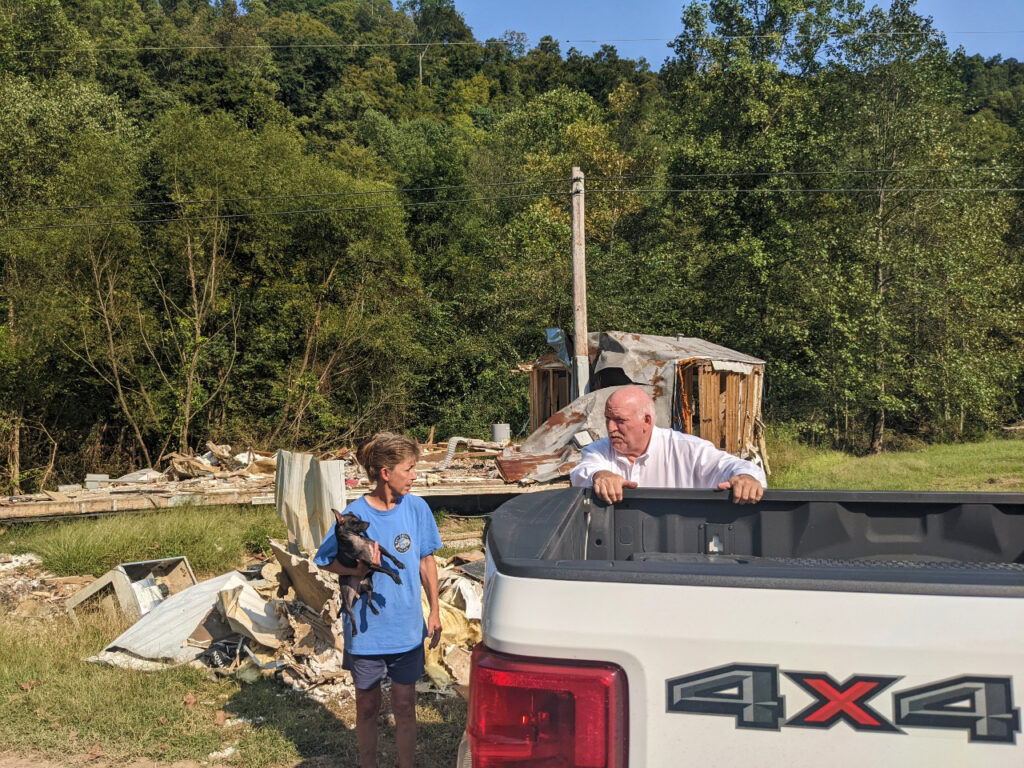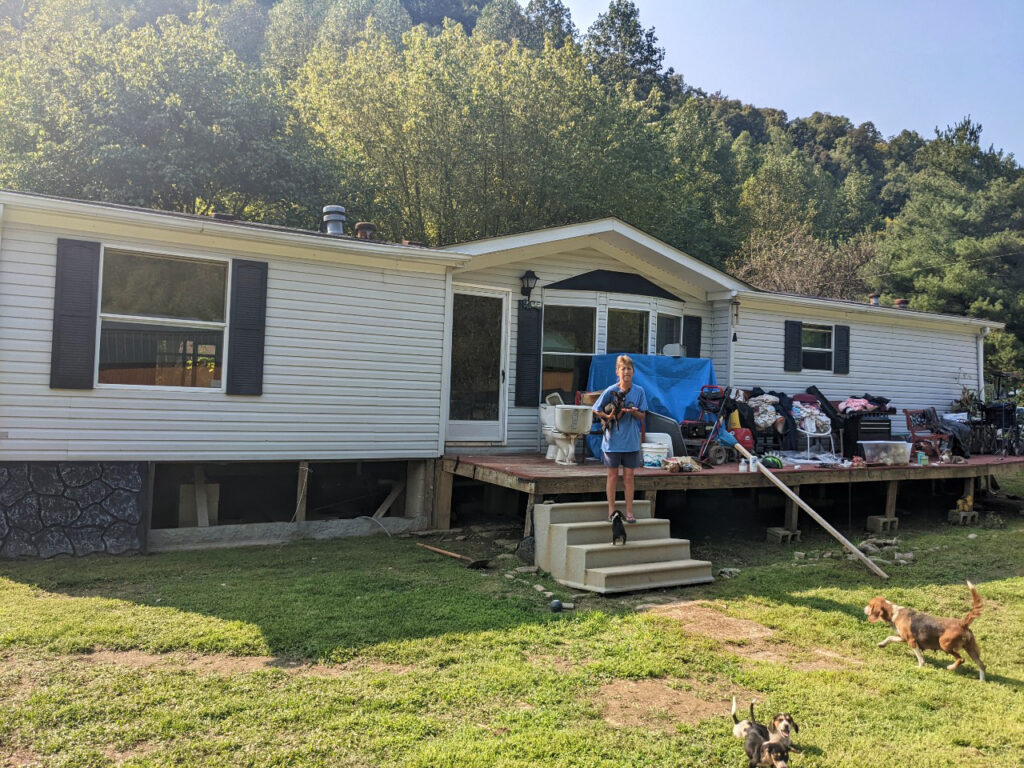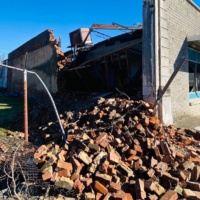This story was produced as part of a collaboration with the Center for Public Integrity, Columbia Journalism Investigations and Type Investigations.
Clay County Emergency Management Director David Watson sees signs of recovery all over Oneida, Kentucky, where flood waters tumbled down the mountains and ripped through town in late July.

By mid-September, when a reporter joined Watson for a ride-along, debris had been cleared from driveways, new mailboxes stood in front yards and construction crews were fixing crucial roads that the floods previously made impassable.
Watson’s job is to coordinate rebuilding efforts for the eastern Kentucky county. But he said floods are becoming more common and more dangerous here, and Watson worries recovery won’t be enough.
“Every time we have these flash flood warnings, we’re sitting and holding our breath, just praying that it dissipates before it hits little Oneida,” he said.
Watson isn’t just responsible for recovery alone. He’s also the person tasked with making Clay County safer and more resilient in the face of future floods through a process known as hazard mitigation planning.
Watson knows this preparation is important. But repairing what’s been damaged, helping people who lost everything get back on their feet and getting Clay County back to something resembling normal is demanding in itself.
Watson said the job has been like drinking through a firehose.
“At the end of the day, counties focus on getting their roads and bridges built back to pre-disaster conditions,” Watson said. “Then when you look at hazard mitigation, sometimes you think that’s the least thing from my mind right now. As a county, it probably should be one of our top five priorities.”
The idea is to reduce the harm that future extreme weather events cause people and property with long-term solutions like fortifying bridges to withstand repeated flooding, building storm life-saving shelters and helping people relocate from flood-prone properties stuck in a cycle of disasters.
But preparing for the next calamity while still recovering from historically devastating weather is a daunting task for county emergency planners across Kentucky. Especially planners like Watson who could use a lot more support coordinating complicated projects and securing federal funding to pay for mitigation.
Few counties can afford to implement robust mitigation plans without federal support, and they face barriers that make it hard for some of the state’s most disaster-prone communities to get the help they need.
Most of the hazard mitigation money set aside by the Federal Emergency Management Association doesn’t reach counties until well after a disaster. Some counties can’t afford to put up their portion of the funds (FEMA grants will cover as much as 90% of the costs, states and local governments provide the rest).
Any county in the state can apply for hazard mitigation funds that become available after a disaster, even if they weren’t directly impacted. As a result, some communities already reeling from recent disasters struggle to complete a complicated and time-consuming application process that can pit them against wealthier communities also vying for the grants.
A Kentucky Center for Investigative Reporting analysis of federal hazard mitigation spending shows just how unevenly the money has been distributed as a result, reflecting a process based more on competition than on need. Communities directly impacted by Kentucky’s recent disasters received comparatively fewer federal hazard mitigation dollars – averaging $24 per capita in hazard mitigation assistance funding since 1988 compared to an average of $36 per capita for Kentucky counties spared from the storms.
KyCIR conducted the analysis using data from a recent project from Columbia Journalism Investigations, Type Investigations and the Center for Public Integrity that examined the complicated bureaucracies preventing many communities directly impacted by climate change from winning federal mitigation grants. The project also highlighted how the system is struggling to keep up with climate change’s rising stakes.
Kentucky – which saw more flood-related disaster declarations than any state from 2000 to 2022 – is a prime example of this disconnect.
Of the 29 counties eligible for FEMA aid after the tornadoes and floods, four counties have never received any hazard mitigation funds. Of those four counties, which have some of the highest poverty rates in the state, only Clay County employs a full time planner working on emergency management.
University of Iowa professor Eric Tate studies the connection between poverty and weather disasters. He said the competitive grant process FEMA uses to distribute hazard mitigation funds exacerbates the nation’s already unequal response to climate change.
Wealthier, whiter and less rural communities are often better equipped to handle the administrative burden it takes to secure FEMA hazard mitigation grants, Tate said. At the same time, officials in communities with predominantly rural or minority populations whose constituents are more likely to live in disaster-prone areas often fail to even apply.
In that way, few disasters can truly be called “natural,” Tate said. “They are disasters, but because of the way we organize society, the fact that we have such inequality and discrimination… that is what’s leading to all of these problems.”
Oneida
Joyce Johnson said she has lived in a small valley near Oneida since she was seven.
Seven weeks after the July 28 flood, the only items inside Johnson’s home were a few broken appliances and a muddy Bible resting on a dented clothes dryer. The walls had been stripped down to the studs, leaving a four-foot gap to the floor.

Johnson pointed to a hole in her bedroom where the flood slammed debris through the side of the house. She said she was thinking about leaving.
“We’ve worked our hearts out,” Johnson said. “But if it happens again, I’m leaving. I can’t handle this. This is awful to see your home destroyed and no way to put it back.”
Johnson said she was raised in a house higher up the valley, where her parents still live. In her 50 years living in the area, she remembers the creek rising plenty of times, but said flooding has become a more serious problem in recent years.
In March 2021, a flood damaged the floors and insulation in the mobile home down by the creek where Johnson’s niece lived. Her niece had only recently moved back into the trailer when the creek flooded again this July. That flood carried the trailer about 30 feet and slammed it against a utility pole as the family watched from a porch nearby.
Johnson’s niece is now renting a home in town while Watson, the county emergency director, raises the money to repair the mobile home and move it up the valley and out of the flood zone.
Counties can use hazard mitigation funds to relocate people out of flood paths, but the process is often too slow and cumbersome to be an effective option. Instead, Watson plans to use donations from community groups to move the trailer before winter arrives. He visited Johnson in September to scout the new site.
“Hazard mitigation money could fund this,” Watson said. “But she’s got to get her family back in the house. She can’t wait a year and a half ‘til hazard mitigation finally kicks in, and they say, ‘Hey, here’s some money for you guys.’”

Watson said he’s been learning more about the hazard mitigation process since the July floods.
Federal and state emergency management officials announced a new round of hazard mitigation funding tied to the disaster on Sept. 7. Watson said four families in Clay County have expressed interest in using hazard mitigation funds to purchase properties in flood zones so they can relocate, and Watson is gathering the materials needed to package their application.
Watson works for Clay County, which has one of the highest poverty rates in the state, in addition to a full time job as the engineering director at the local hospital. He’s been in the position for 13 years but said he hadn’t applied for a hazard mitigation grant before because the county had other priorities for their limited resources, and he doesn’t have the staff.
“It really would take one staff member to do nothing but hazard mitigation planning, applications, follow through, and the whole nine yards,” said Watson.
Kentucky Emergency Management spokesperson Angie Van Berkel said in an email that the agency works with Kentucky Area Development Districts, regional focused planning and development agencies, to provide technical resources for communities that want to apply for grants. A representative from the Cumberland Area Development District, which represents Clay County, did not respond to requests for comment.
‘A bit of a mystery’
FEMA gained the authority to provide funding for disaster preparation in 1988. Kentucky is one of 15 states with an enhanced hazard mitigation program, allowing for more federal money for hazard mitigation after every disaster.
Counties that want funding must submit grant applications to the Kentucky Mitigation Council, which is part of the state’s emergency management division. The council is composed of representatives from local government and state officials including Kentucky Hazard Mitigation Officer Geni Jo Brawner, floodplain coordinator Alex VanPelt and Division of Water Director Carey Johnson, with support from the University of Kentucky’s Hazard Mitigation Grants Program Office. Counties submit their proposals, and the council decides what to pass along to FEMA for approval.
Drew Chandler, emergency management director for Woodford County, said most local emergency management officials aren’t totally aware of the criteria the council uses to review requests.
“It’s a bit of a mystery,” said Chandler, also the outgoing president of the Kentucky Emergency Management Association, a nonprofit organization for emergency management professionals in the state. His county has received $2.3 million in hazard mitigation funds since 1988 to take on projects such as distributing emergency radios to people living in the floodplain and elevating a historic log cabin near Woodford Reserve distillery.
“I would like to think that the priority does, in fact, go to the counties that were impacted by the disaster,” Chandler said. “But I wouldn’t want to do that job because of the complexities and having to make decisions about which project is more worthy than another.”
Jessica Elbouab, a spokesperson for Kentucky Emergency Management, the state agency in charge of coordinating disaster response, said in an email that the council prioritizes communities that were directly impacted by the floods.
The agency provided KyCIR a list of projects approved by the council after the December tornadoes. The list showed 78% of the $134 million in federal hazard mitigation funding went towards projects in counties eligible for individual or public assistance relief. Another 21% went towards counties that were not directly impacted by the storm, with the rest going towards statewide projects. Kentucky received another $3.5 in federal funds to support regional or statewide planning projects.
The counties that suffer the most disasters aren’t necessarily the ones that get the most FEMA funding for disaster preparation.
In eastern Kentucky, Letcher and Owsley Counties saw five and seven natural disaster declarations, respectively, between 1988 and 2020. FEMA data shows neither received hazard mitigation money during that period. Fayette County, the state’s second most populous county, was named in one declaration but got $16 million over that same span.
Kentucky Emergency Management spokesperson Van Berkel said in an email that Letcher and Owsley County have never applied for hazard mitigation funding and that Fayette County was the site of a $12 hazard mitigation project awarded after flash floods killed two people in 2006. Van Berkel also said that the threshold for a disaster declaration is higher in more densely populated counties.
“This doesn’t negate the need for mitigation,” Van Berkel said. “If impacted counties are not applying, rather than forgoing the FEMA funding, it is important to submit as many project proposals as possible to ensure all floods are utilized.”
Elbouab said the council typically looks for projects that will prevent future disaster damage, have passed a cost-benefit analysis and avoid harming the environment.
The council also makes funding decisions based on the state’s hazard mitigation plan, which explains the disasters that threaten Kentucky. The 2018 document established broad goals, such as educating people about mitigation strategies and doing a better job coordinating and prioritizing mitigation.
These plans will become more important as climate change brings stronger storms and heavier rainfall to Kentucky and other parts of the U.S.
FEMA Administrator Deanne Criswell called climate change the country’s biggest crisis in an August 2021 press release announcing a $3.5 billion commitment to hazard mitigation efforts across the country. FEMA allocated Kentucky nearly $22.8 million of the money to fund projects that lessen risks posed by natural disasters. But state and federal officials have not yet answered questions about how the money will be spent.
Emergency planners make a big difference
There are 45 counties in Kentucky with part-time emergency management directors, according to a list provided by Kentucky Emergency Management. Counties with full-time emergency planners tend to have more success securing federal hazard mitigation dollars.
The five counties that have received the most grant assistance all have someone working full-time in that role.
For the last 26 years, Ronnie Pearson has served as the full-time emergency management coordinator in Warren County, which has received $2.8 million in hazard mitigation grants since 1988. Pearson has used mitigation grants to build six storm shelters around the county, among other projects, with help from a deputy director and a full-time grant writer he shares with the rest of the county government.
Pearson said the structures provided shelter for 200 to 300 people when tornadoes hit the county last December. Eighty people died in that outbreak, 17 of them in Warren County.
Emergency planners in at least 12 counties have used hazard mitigation funds to build at least 67 storm shelters in Kentucky, most of them near the state’s largest cities and in counties with full-time emergency management directors.
Graves County has received $187,000 in hazard mitigation funds since 1988. But there were no storm shelters in Graves County last December when the tornadoes killed 24 people there. Emergency Management Director Tracey Warner has since secured hazard mitigation money from FEMA to build six shelters.
Warner has served as Graves County’s first full-time director for the past three years. The Kentucky Emergency Management Association named Warner their “manager of the year” for her service to the county in the aftermath of the tornadoes.
She is now preparing applications for funding tied to the flooding in eastern Kentucky to take on other necessary improvements, such as building a more resilient emergency operations center.
“Whether I get it or not, it’s fine,” she said. “You just keep asking.”
Not every county has a full-time emergency manager like Warner or Pearson.
Nine of the 29 counties most impacted by recent disasters had part-time emergency management directors, according to data from the state, according to data from the state and KyCIR’s reporting. At least four of the counties whose emergency management directors are listed as full-time share other responsibilities such as coordinated 911 services or acting as the counties floodplain coordinator.
Letcher County emergency management director Paul Miles works part-time. He retired in 2017 after a 30-year career in law enforcement and accepted the part-time emergency management role less than a year later.
When the flood hit in late July, Miles remembers coordinating first responders helping the rescue effort in his county using an emergency radio as he fled the flood waters in his truck. His office and two backup emergency operation centers had flooded. All the county’s emergency response vehicles were swept into the North Fork Kentucky River.

For Miles, figuring out long-term solutions will have to wait.
In mid-September, the county’s search and rescue truck was still tangled in a sycamore tree.
“We still have roads that aren’t open. We have people that have their driveways washed out that are impassable,” Miles said. “We have not cleared this hurdle yet.”
Letcher County has never received any hazard mitigation money, and Miles has never applied for a grant. Miles said the county had had problems with flooding before, but not to this extreme. So, leaders focused on other priorities, like coordinating a volunteer search and rescue team.
FEMA will reimburse the county for flood repairs after a separate complicated approval process, and any hazard mitigation projects will require the county to pay for a portion of the costs. Many counties in Kentucky struggle to keep up with their mitigation plans already. Miles said that even with COVID-19 relief funds, Letcher County’s limited resources are tied up with simple repair and maintenance.
“With our roads right now, there’s so much damage I don’t know where the money is going to come from,” Miles said.
‘FEMA should simplify as much as possible’
FEMA knows accessing hazard mitigation funds is a challenge for many communities.
The agency agreed to find ways to simplify the application process after a 2021 Government Accountability Office report found many local governments struggled with the complexity of the grant application process. Others had access to technical expertise or could hire expensive consultants to navigate the paperwork.
FEMA recently solicited public comments to inform potential changes to the agency’s hazard mitigation Program and Policy Guide, which was last updated in 2015.
In one public comment, the Association of State Floodplain Coordinators, a nonprofit organization for people working to reduce flood loss, said FEMA’s hazard mitigation program keeps getting more complex. “More complex programs are almost impossible for low-capacity jurisdictions to administer, FEMA should simplify as much as possible,” the association wrote.
The association said FEMA should let states run their own hazard mitigation grant programs so they can respond to disasters without seeking federal approval for projects.
Tate, of the University of Iowa, said FEMA should invest more in so-called technical assistance grants that help under-resourced communities manage the complicated grant process.
“Larger and wealthier communities are the ones that have those capabilities already,” Tate said. “So, it’s easier for them to compete for these projects than the smaller, rural, poor communities.”
FEMA provides some money to help under-resourced communities with the process. but Tate said that investment has so far been too small to close the gap. Kentucky has received $191,000 in technical assistance since 1988. Emergency management officials have used that money to support salaries and training, according to FEMA data.
Stephen Eisenman, founder and strategy director at the Anthropocene Alliance, a nonprofit that helps communities across the country prepare for climate change, said that Congress could rewrite the grant program and distribute the funding more equitably — especially if voters support candidates who acknowledge the threats posed by climate change and want to invest in mitigation.
“Kentucky’s being screwed over by the storms, and so has almost every other state and city in the South, and yet, that’s where the least political support for action on climate change is,” Eisenman said.
KyCIR reached out to the office of U.S. Congressman Hal Rogers, a Republican representing most of eastern Kentucky who has helped secure more than $800 million in flood control studies and projects in his district, to ask about FEMA’s hazard mitigation program. His spokesperson didn’t follow up with KyCIR’s interview requests by publication time.
KyCIR also sent interview requests to the chairs and vice chairs of both the Kentucky Senate and House energy and environment committees to discuss the state’s disaster mitigation programs. They did not respond to inquiries.
When recovery isn’t enough

FEMA pays for some smaller-scale mitigation projects, such as reinforcing damaged roads, as part of its Public Assistance program for reimbursing counties’ cleanup and recovery costs. Unlike hazard mitigation grants, that money is designated for counties hit by a disaster.
Watson said most of that spending in Clay County will go toward getting things back to the way they were before the flood, to what FEMA calls “pre-disaster conditions.”
The problem, Watson said, is that repairing the damage doesn’t solve the problems like unstable infrastructure that made the last flood so destructive.
As he drove through Oneida one day in September, Watson pointed out a large pipe that became clogged with debris, causing the water to spill over the road and flood nearby homes. Watson said FEMA might reimburse the county’s spending on repairing the pipe, but it will still probably overflow again during a heavy rain.
“Here’s the reality: you can spend a half a million dollars going up the holler, repairing roads and bridges, doing bank stabilization, ditching, asphalt repair, all the above,” Watson said, but if the county doesn’t find long-term solutions to infrastructure problems, “it’s all gonna be wiped out again.”
Many policies the county is navigating were written by Congress decades ago. Watson worries what’s on the books now can’t keep up with the disasters Clay County is facing. He said he hopes federal officials learn from what’s happened here and consider updating disaster policies to make it easier for people to access much-needed aid as disasters become more frequent.
If officials really want to improve the hazard mitigation assistance process, Watson said they should do a better job spreading the word about how it works so that more counties like his can take advantage of federal grants.
“I think the biggest part of the improvement is education right now,” Watson said.
This article first appeared on Kentucky Center for Investigative Reporting and is republished here under a Creative Commons license.






